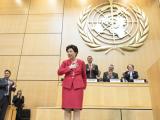May 18, 2010 (CIDRAP News) – An analysis of the H1N1 influenza pandemic in Ho Chi Minh City, Vietnam, suggests that the government's initial policy of screening incoming travelers might have delayed the start of widespread community transmission of the virus by a few weeks.
In late April of 2009, shortly after the detection of the new virus, Vietnamese authorities began mandatory screening of arriving air travelers, including body temperature scanning and a symptom questionnaire. The virus was widespread in Ho Chi Minh City by the second half of July, according to the study, published today by the online journal PLoS Medicine.
"The containment measures seemed to delay the onset of large-scale transmission by at least 3 weeks, said corresponding author Dr. Maciej Boni of the University of Oxford, in a press release from the Wellcome Trust, one of three organizations that sponsored the study.
"This may not sound like a lot, but in a country like Vietnam this bought valuable time for the local health services, laboratories and travel authorities to understand what was happening and start logistical preparations for the pandemic response," Boni said.
The findings do not prove that the containment measures delayed the epidemic, and the authors say they are doing further research to confirm or exclude their tentative conclusion.
Vietnam launched its airport screening program on Apr 27, 2009, when the World Health Organization moved its pandemic alert to stage 4, the report says. From then until Jul 9, 630,778 passengers arrived at Ho Chi Minh City on international flights. The screening procedures intercepted 967 of these (0.15%). They were hospitalized in isolation, tested for the virus, and treated with oseltamivir if positive.
Diagnostic data were available for 450 of the 967 intercepted passengers, 200 of whom tested positive for H1N1 between Apr 27 and Jul 24. The researchers also gathered data on 169 Ho Chi Minh City residents who had not traveled but who, in the same time frame, were tested for H1N1 because of contact tracing or after presenting at city hospitals with flu-like symptoms. Of these 169 patients, 121 tested positive.
The researchers calculated that in the first 9 weeks of the pandemic, H1N1 patients spent 79% of the days when they were infectious in isolation, which suggests a two-fold or greater reduction in their infectious capability, the report says. The team assumed patients became infectious when they got sick or tested positive; they acknowledge that an infected person can become infectious before having symptoms, but they had almost no data on the presymptomatic period.
The authors say the outbreak response was more effective against travelers than nontravelers: the travelers spent 10.1% of their potentially infectious time out in the community, while the nontravelers spent 42.2% of their time at large.
The first H1N1 case in Vietnam was reported on May 31, in a student who had returned from the United States on May 26. The first case of community transmission followed on Jun 5, and two large school outbreaks surfaced in the third week of July, signaling that community transmission was well under way.
"The epidemic in [Ho Chi Minh City] was clearly not containable, a conclusion easily inferred from previous mahthematical anlyses," the report says. However, "The containment program of screening, isolating, and treating suspected cases probably had a notable impact" on the virus's spread in the period studied.
To further test this hypothesis, the authors say they are currently following a group of healthy people to assess the frequency of asymptomatic H1N1 cases. "If the asymptomatic fraction turns out to be small or negligible, control measures may have delayed sustainable community transmission," they write. "If the asymptomatic fraction is large, control measures likely had no effect."
They add that the costs and benefits of airport screening "must be evaluated in light of the relative risks of disease introduction as well as the opportunity cost of concentrating public health resources on slowing the inevitable importation of one disease," which is difficult because the costs of the containment effort are unknown.
Hien TT, Boni MF, Bryant JE, et al. Early pandemic influenza (2009 H1N1) in Ho Chi Minh City, Vietnam: a clinical virological and epidemiological analysis. PLoS Med 2010 May 18;7(5) [Full text]


















